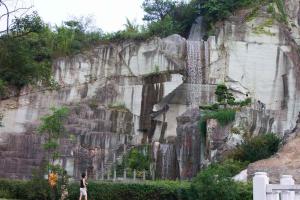|
|
|
说明:双击或选中下面任意单词,将显示该词的音标、读音、翻译等;选中中文或多个词,将显示翻译。
|
|
|
1) intuitive wisdom

中观般若
1.
In the period of East Jin Dynasty, the Buddhist theory of intuitive wisdom prevails in China.
东晋时期,中观般若理论在中国达到高峰。
2) Prajnaparamita sight

般若观照
1.
The author of this paper indicates that the critical reason of Xie Lingyun s poetic success is the application of Prajnaparamita sight in his aesthetic activity.
作者认为,把般若观照与山水审美活动相结合,是他取得这些成就的一个关键原因。
3) the nihilism-standpoint of BAN LUO

般若空观
1.
To compose his soul which was troubled and scared, he tried to get the truth of soul by reflecting conduct with the nihilism-standpoint of BAN LUO and finally find out the downrightest deliverance described in the poem "when I find the truth out,all difficulty will wind up" becauce he had some relationship in destiny with Buddhism .
谢灵运身处晋宋易代的动乱之世,为了安定自己惊恐忧惧的灵魂,因着与佛教的种种因缘关系,他企图以般若空观来观照事物,求得性灵真奥,实现"至乎一悟出,万滞同尽尔"的彻底解脱。
4) Boluo Kong ideology

般若空观思想
1.
The paper discusses the connotation in Xie Lingyun s Buddhistic ideology in the following aspects:Mahayana Boluo Kong ideology,Pure Land belief and the opinion that prays to Buddha,cultivating himself according to th.
本文从大乘般若空观思想、净土信仰与念佛禅修、不废渐修的顿悟主张三方面探讨了谢灵运佛教思想的内涵 ,以期更深入全面地理解其山水诗文。
5) prajna
['pɔtsədʒnə,'pɔtsənjɑ:]

般若
1.
The prajna thoughts in Analects of the Sixth Chan Patriarch Huineng are generally analyzed in such aspects as "void", middle path and "no difference".
常见研究将《坛经》的般若思想分析为"空""中道""无分别"等方面,这种方法流于简单,没有区分《坛经》对般若思想的侧重与择取。
2.
The non-systematic understanding of Chinese monks with regard to the Indian concept of Prajna and Sunyata thus gave rise to six different schools and seven different sects.
佛教传入中国的初期,一直受到中国思想的影响,中国僧伽对般若学无法进行系统地了解,因对空的思想理解不同才形成了六家七宗的局面。
3.
The paper applies the methods of macroscopic descriptive and microscopic analysis,takes the poems of Wang Wei and Daoji for example,explores the soul secret of some ancient poetry,compares it with prajna which exists in Tanjing,and then gives some new concepts of literary theory.
运用宏观勾勒与微观分析、理论阐释与实例印证相结合的方法,以王维、道济等人的若干作品为例,解读出蕴含于诗情禅境中的心灵秘密,指出《坛经》般若境界与某些相似诗禅境界的联系与区别,并借此提出一些重要的文论概念,如死境、活境等。
6) Banruo spring

般若泉
1.
The Banruo spring is located near the Shuxiang temple of Taihuai town of WutaishanBuddhism resort.
般若泉位于五台山佛地台怀镇殊象寺旁,交通方便,环境优美,泉水流量大、水质好。
补充资料:般若谷
般若谷景点始建于2001年2月,原为明代采石场。经匠心独具的构思、设计和建设,以石宕深窟、溪流水塘、山林花草为载体,以汉白玉石经幢为标志,添建瀑布、地池、石阶、栈道、隧洞、地宫,连成一体,在石壁上分别以线雕、浮雕、深雕、圆雕(石窟雕刻)、彩绘,刻绘佛本生故事、四大菩萨以及早期新昌境内诸多佛教典故。 般若(bo re),系梵文音译,即大智大慧,景名“般若谷”为贺敬之所题。汉白玉经幢高9米,柱上镌刻般若波罗密多心经,正前方一飞瀑从天而降,落差约为50米,共分七级,“七级”之数正好与佛语“七级浮屠”相合。“禅源“二字为赵朴初所题,大佛寺开山祖师昙光为“习禅之祖”,在大佛寺修禅53年,比达摩祖师到少室山“面壁”至少早一百多年。大佛寺在东晋时“般若学”、“禅学”并重,因此题为“禅源”。 景点内有佛祖释迦牟尼的出生像,脚踩莲花,一手指天,一手指地,寓意“天地之间,唯我独尊”。释迦牟尼出生像象征了佛教的起源。右边是释迦牟尼在菩堤树下成道的线雕图案,成道像象征了佛教在印度的发展。沿台阶往上走,岩壑陡壁,喻意佛教文化传到我国传布者经历的跋山涉水之艰苦。经过第二级瀑布,拾级而下,正前方是一幅12米、高25米宽的石壁浮雕像,画面场景为南朝时期大批高僧名士云集剡中(今新昌),研究佛教般若学,还有昙光开山、支竺遗风、般若创宗、三生圣迹、智者圆寂等典故,以及白居易在《沃洲山禅院记》中提及的王羲之、孙绰等游止于新昌的十八名士。这是一幅佛教中国化的巨型历史画卷,示意了佛教在中国的立足,也体现了新昌在佛学史上的地位。瀑布层层下跌,激起巨大的轰鸣声,喻意我国传统文化与印度佛学在激荡中包容了佛学,最后成为影响深远的一大中国文化。隧道中间有一石室,曰“光华世界”,中间为两尊毗卢遮那佛,四面是镜子,金碧辉煌,“光华世界”示意了佛教在中国的发扬光大。出隧道,迎面是20米高的鳌鱼观音像,还有文殊菩萨,今后还要在周边雕凿普贤、地藏王菩萨。我国有佛教四大名山,分别是四大菩萨的道场,这四大菩萨象征了佛教在我国的普及。 般若谷布局绝妙,喻意深刻,是当代新景点的典范之作,有“江南敦煌”、“地下佛国”之美誉。
说明:补充资料仅用于学习参考,请勿用于其它任何用途。
参考词条
|






